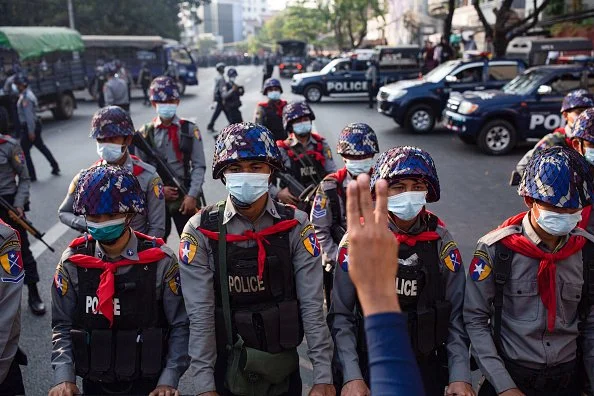Mass Atrocity Resistance –Research project and workshop series
Photo by Aung Kyaw Htet/SOPA Images/LightRocket via Getty Images
The Mass Atrocity Responses project is convening a series of online and hybrid workshops on resistance to human rights abuses and mass atrocities, focusing on geographical regions or specific sub-topics. With the workshops, we are building a network of scholars and experts with a common research interest, and identify topics and cases for further study. We have convened an in-person/hybrid workshop focusing on papers intended for publication in an edited volume.
In 2021, a series of workshops looked at Myanmar, Iraq and Ethiopia in particular, and the project hosted a panel focusing on South East Asia at the Euroseas conference in June 2022. Workshops on South East Asia, the Americas and resistance to jihadi violence were convened from October 2022 to January 2023. In March 2023 we convened a workshop on the role of religious actors in atrocity resistance. The paper-based hybrid workshop was convened in May 2023 with 20 participants. An open call for papers was issued in January 2023.
The Mass Atrocity Resistance research project
In the international policy and research field of mass atrocity prevention, there is a strong normative emphasis on the duty of outsiders to rescue victim groups either through political pressure or through more forceful economic and military measures. However, the reality of mass atrocities (understood here as large-scale violence against civilians) is that victim groups usually have to protect themselves. There is a need to better understand the strategies threatened groups employ to protect themselves against atrocities, and how these groups may be able to mobilize support domestically or internationally.
Questions asked in the project include:
Is it possible to see resistance strategies to mass atrocities as something distinctive from resistance to human rights abuses or armed conflict? If so, how?
How have vulnerable groups on the ground resisted threats of mass atrocities? Is it possible to identify a pattern of resistance strategies across different cases?
What are the most central actors of resistance in each case?
Do resistance strategies change over time, during different phases of a conflict?
How have resistance options been influenced by regional and global political power shifts, alongside national regime changes?
The project studies resistance strategies comparatively. Resistance actors can include non-violent CSOs, trade unions, religious communities, armed resistance movements, political groups, women’s groups etc. They can also include larger groups of civilians who belong to a certain community but who do not constitute an organized CSO or political group. These actors may or may not make appeals to international or regional actors in their resistance strategies. The project is not limited to a specific collection of cases/regions. The aim is to identify patterns across cases and actors, as well as furthering a better understanding of resistance in each case.
Edited volume
The project continues throughout 2024, with the aim of publishing an edited volume on the topic. Although the call for papers is now closed, please get in touch for inquiries and if you are interested in the project.
Authors have been encouraged to submit papers that discuss at least one of the following topics:
Actors: Who are the most central actors of resistance in each case? How do identity markers (gender, religion, ethnicity) and group membership influence resistance? What motives do resistance actors have to cooperate with or join a specific group (self-preservation, affinity, religious convictions)? How do resistance options vary when perpetrators are non-state actors?
Strategies: What type of actions constitute resistance to mass atrocities? Are certain strategies more legitimate than others? Is it possible to identify a pattern of resistance strategies across different cases? Is it possible to see resistance strategies to mass atrocities as something distinctive from resistance to human rights abuses or armed conflict? Are the risks of resistance significantly different depending on recent histories of mass atrocities? How can the effectiveness of resistance strategies be measured?
Dimensions: Do resistance strategies change over time, during different phases of a conflict or atrocity escalation? How have resistance options been influenced by regional and global political power shifts, alongside national regime changes? Do resistance options differ in the absence of armed conflict? What effects can international accountability mechanisms have on local resistance movements and the prevention of atrocities? What role do memory and documentation of past abuses play in shaping future resistance strategies?
Project group:
This research initiative is part of the project Mass Atrocity Responses, coordinated by Ellen E. Stensrud at the Norwegian Center for Holocaust and Minority Studies, and funded by the Norwegian Ministry of Foreign Affairs.
The project group consists of:
Ellen E. Stensrud, Senior Researcher, Norwegian Center for Holocaust and Minority Studies.
Gyda M. Sindre, Senior Lecturer, University of York
Claire Q. Smith, Senior Lecturer, University of York
